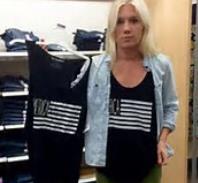Is Peloton Spinning Its Wheels? Peloton Petitions to Cancel “SPINNING” Registrations

Target and T-Shirts – Where Does Copyright End and Fashion Design Protection Begin?
by Guest Blogger
Last week, queen blogger Mari-Elise Taube wrote about Melissa Lay and her social media battle with Target over its sale of the #Merica tank top. A picture of Ms. Lay and the Target version of her product appears below.

As you now know, this "patriotic themed" tank top that reproduces the American flag in black and white and with some liberties, was the subject of a David and Goliath battle between a small Etsy entrepreneur and retail behemoth Target.
As Mari-Elise concluded in her writing on the subject:
"While the copying of the #Merica tank doesn't constitute trademark infringement, it does constitute copyright infringement. Copyright is a form of protection provided to the authors of original works of authorship, including literary, dramatic, musical, artistic, and certain other intellectual works. Copyright protection vests immediately upon creation, and copyright owners can, among other things, prevent third parties from reproducing and distributing copyrighted works."
I agree. The tank top design, assuming it originated with Ms. Lay (and there has been no reason to believe otherwise) displays the requisite amount of "originality" in its use of the scrawled word "AMERICA" in place of the usual stars and its incorporation of seven "wavy" white lines in place of stripes to qualify for protection under the U.S. Copyright Act. Even though certain well-known symbols and geometric designs are denied copyright protection for failure to satisfy the law's requirement for a "modicum" of creativity, this design arguably made it over the line.
So is the same true for other "fashion designs" that originate with fashion designers? No. Although proposals have swirled for as long as I can remember, the Copyright Act does not currently provide protection to fashion designs per se. Although the fashion industry is a multi-billion dollar industry, Congress has yet to come to terms with legislation that would extend rights in original works to the design of fashion articles.
Many other countries, including in the EU, do offer certain legal protections to fashion designs that the U.S. does not. And in this country a skilled practitioner may be able to "fit" certain protectable elements of design (for example, the distinctive pattern used on fabric from which the design is sewn), labeling, or other "trade dress" associated with an original garment to assert intellectual property rights against competing "knock offs."
The reasons offered for the gap in protection vary from the quickly changing nature of the fashion industry to the need for designers to "borrow" from others as inspiration to advance fashion "trends."
In fairness, Ms. Lay's claim to rights was arguably limited to the particular design placed on the t-shirt, and not to the tank top's overall design as a whole. In other words, had Target used the design on a cookie tin, she could have asserted the same objection. And her approach to dealing with the problem, taking to social media with what was by all accounts a direct rip-off of her work, is a lesson in street smarts, not intellectual property law.